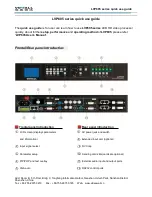
Atmosphere
User Manual
AtlasIED.com
TELEPHONE: (800) 876-3333
1601 JACK MCKAY BLVD.
ENNIS, TEXAS 75119 U.S.A.
– 41 –
Accessories Overview
Six plug and play smart wall plate accessories can be populated on AZM accessory ports to add remote source inputs or provide zone control.
Accessories include:
•
3 x audio inputs- balanced mic/line XLR, dual RCA stereo summed with 3.5mm, and Bluetooth® audio wall plate inputs.
•
2 x controllers- volume controls, volume controls with source select, scene recall, and message playback
•
1 x ambient noise sensor for Ambient Noise Compensation control.
Any control accessory can be daisy chained on a single cable digital bus and assigned to any zone, reducing installation wiring time and complexity.
Virtual control can be established with any mobile device by QR code scanning.
Note:
For audio wall plates
A-XLR, A-RCA,
and
A-BT
, see
Audio Wall Plate Inputs
earlier in this manual.
Controller Accessories
1.
C-V
– Volume Control
2.
C-ZSV
- Volume Control with Source select, scene recall, and message playback
3.
X-ANS
– Ambient Noise Sensor for supplying ambient noise levels to the Ambient Noise Compensation algorithm
4.
GEM
– Wall mountable frame/placard to hold a virtual wall controller QR code printed from the user interface.
Controls for the QR code can be opted in the user interface.
The Accessories UI page is where you add and configure settings for the following:
•
Virtual Controllers (Mobile)
– Any mobile device can be turned into a controller by using the “+ ADD NEW” setup to create a QR code to
scan and instantly use your mobile device to access the same features as a wired controller. (no app download required)
•
Front Panel Display
– Select QR Code to enlarge and scan with mobile device, a front panel UI screen will display access to control zones,
sources, and volume levels.
•
Accessory Ports
A-B (AZM4) or Ports A-B-C-D (AZM8) – All wall plate accessories are connected to the AZM accessory ports. These ports
populate as you connect the wired accessories and the AZM detects them. Once detected, they appear on the port as shown below.















































